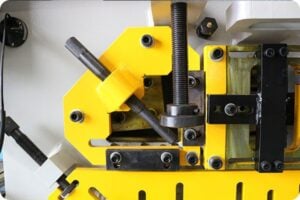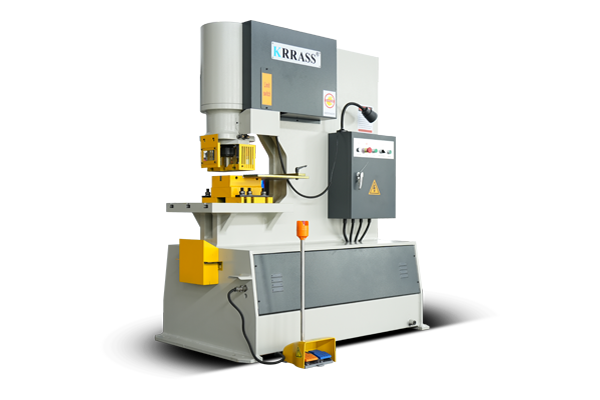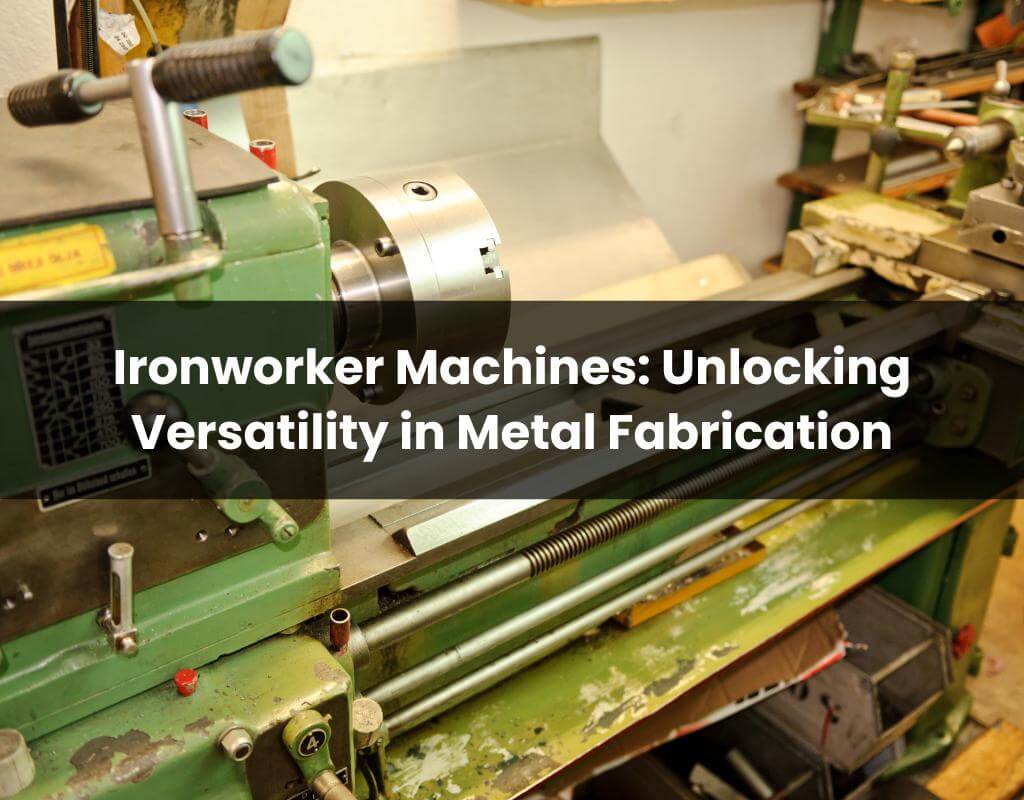Ironworker machines are the cornerstone of metal fabrication, known for their multifunctionality and efficiency in performing tasks like shearing, punching, bending, and notching. These compact yet powerful tools are essential in various industries, streamlining operations by combining multiple processes into one unit, saving time, space, and cost. With their adaptability and ease of use, ironworkers are the "Swiss Army Knife" of the fabrication world, proving to be invaluable assets from small workshops to large-scale manufacturing.
Table of contents
4. Key Features and Specifications
5. Safety and Operational Best Practices
7. Choosing the Right Ironworker Machine
1. Overview
Ironworker machines play a crucial role in the construction machinery industry, particularly in working with steel plates and profiles. These versatile units perform various functions, including shearing, notching, and punching holes. In this overview, we’ll explore the different types of ironworker machines, their functionality, advantages, and applications.
1.1 Types of Ironworker Machines
Ironworker machines can be broadly categorized into two main types:
Mechanical Ironworker:
- Utilizes a mechanical linkage to transfer energy to its components.
- Suited for lighter tasks.
- Efficiently combines multiple functions into a single unit, eliminating the need for frequent retooling.
- Designed for user-friendly operation, low energy consumption, and reduced maintenance costs compared to separate machines.
Hydraulic Ironworker:
- Operates using hydraulic pressure to deliver force to the tooling.
- Offers more power and is suitable for heavy-duty work.
- Ideal for metal fabrication tasks that require significant force.
1.2 Functionality
Ironworker machines are multifunctional and can perform the following tasks:
Shear Station
The shear station allows precise cutting of flat bars, angles, and other metal profiles. It can handle different materials, including steel, aluminum, and stainless steel. The shear blades create clean, straight cuts, ensuring accuracy in metal fabrication.
Punching Station
The punching station is where holes are created in metal sheets. Ironworkers come with various punch and die sets, allowing customization based on hole size and shape. Whether it’s round holes, slots, or special patterns, the punching station delivers consistent results.
Notching Station
Notching involves removing a portion of metal to create V-shaped or rectangular cutouts. Ironworkers excel at notching, enabling precise fabrication of angles, channels, and other structural components.
Bending Station
The bending station forms metal into angles, channels, and other shapes. Ironworkers have adjustable bending dies, allowing operators to achieve the desired bend angle. From
2. Applications
2.1 Steel Structure Processing
Ironworker machines play a pivotal role in the steel structure industry, enabling efficient cutting, punching, and bending of steel materials for various applications. These versatile machines are indispensable in constructing high-rise buildings, bridges, and industrial facilities.
Specific Applications:
- Beams Fabrication: Ironworkers precisely cut and shape steel beams, ensuring structural integrity.
- Columns Manufacturing: Ironworker machines create columns with precision, meeting design specifications.
- Plate Cutting for Structural Components: The machines cut steel plates for use in structural elements.
- Staircase and Railing Fabrication: Ironworkers shape railings and staircase components.
- Truss Assembly: Ironworker machines assemble trusses, critical for load-bearing structures.
- Welding Preparation for Steel Structures: Precise cuts and holes facilitate welding joints.
- Platform Construction: Ironworkers contribute to platform fabrication.
2.2 Elevator Car and Parts Manufacturing
In elevator production, ironworker machines ensure the accuracy and strength of critical components. Elevators rely on precisely shaped frames, brackets, and supports for safe and efficient transportation.
Specific Applications:
- Frame Fabrication for Elevator Cars: Ironworkers create sturdy frames for elevator cabins.
- Bracket and Support Fabrication: Elevator components require accurately punched holes and bends.
- Door Frame Construction: Ironworkers shape door frames for elevator entrances.
- Component Punching for Control Panels: Precise holes are essential for control panel assembly.
- Rail Alignment Parts: Ironworker machines contribute to rail alignment mechanisms.
- Cable Bracket Fabrication: Elevator cables are securely supported by precisely crafted brackets.
- Counterweight Assembly: Ironworkers shape counterweights for elevator balance.
2.3 Trailer Parts Fabrication
Ironworker machines are vital in crafting durable and functional components for trailers. These machines ensure precise cutting, punching, and bending to meet the demands of diverse trailer applications.
Specific Applications:
- Spare Tire Holder Manufacturing: Ironworkers create holders to secure spare tires on trailers.
- Hinge Production for Trailer Doors: Precisely shaped hinges ensure smooth door operation.
- Plate Hooks and Inserts Fabrication: Ironworkers shape hooks and inserts for trailer functionality.
- Trailer Tile Cutting and Shaping: Precise cuts enhance trailer aesthetics and functionality.
- Axle Bracket Construction: Ironworkers contribute to axle support brackets.
- Trailer Frame Assembly: Components for trailer frames are accurately shaped.
- Coupling System Components: Ironworker machines create coupling parts for trailer connections.
These applications demonstrate the versatility and importance of ironworker machines across various industries, from construction to transportation.

3. Historical Perspective
The evolution of ironworker machines is a testament to the ingenuity and innovation in the field of metal fabrication. From their inception, these machines have been pivotal in shaping the landscape of construction and manufacturing.
3.1 The Genesis of Ironworking
The earliest ironworker machines emerged from the need to streamline the laborious process of cutting and shaping metal by hand. These primitive versions were mechanical in nature, relying on gears and levers to amplify human strength for tasks like punching holes and shearing metal.
3.2 Advancements in Ironworking Technology
As the industrial revolution took hold, ironworker machines evolved, incorporating more sophisticated mechanisms. The introduction of hydraulic systems marked a significant leap forward, offering greater force and precision. This transition from mechanical to hydraulic ironworkers mirrored the broader shift towards automation and mass production.
3.3 Modern Ironworker Machines
Today’s ironworker machines are marvels of engineering, capable of executing complex tasks with speed and accuracy. They are equipped with state-of-the-art hydraulic systems and computerized controls, allowing for intricate work that was once unthinkable. The modern ironworker is not just a tool but a symbol of the technological age, representing the pinnacle of metalworking efficiency.
3.4 The Role of Ironworkers in Industry
Ironworker machines have been instrumental in the construction of skyscrapers, bridges, and other feats of engineering. They have also played a critical role in the automotive and aerospace industries, where precision and strength are paramount.
3.5 The Future of Ironworking
The future of ironworker machines lies in the integration of artificial intelligence and robotics, further enhancing their capabilities. As we push the boundaries of what is possible, ironworker machines will continue to be at the forefront of innovation in metal fabrication.
4. Key Features and Specifications
Ironworker machines are quintessential in the realm of metal fabrication, revered for their multipurpose capabilities and robust construction. These stalwarts of the industry are indispensable for their proficiency in executing a multitude of tasks including punching, shearing, notching, and bending of metal materials. This article delves into the intricate details and specifications that make ironworker machines a pivotal asset in metalworking.
4.1 Robust Construction and Design
The architecture of an ironworker machine is a testament to engineering ingenuity, designed to withstand the rigors of heavy-duty metal manipulation. The structural integrity is fortified by the use of high-grade steel and precision engineering, ensuring longevity and consistent performance under strenuous conditions.
Force Generation and Capacity At the heart of an ironworker’s functionality is its capacity to exert formidable force, typically quantified in tons. The force generation mechanism varies, with hydraulic systems employing pressurized fluid for efficient power delivery, while mechanical models leverage kinetic energy through complex gear and lever systems.
Operational Versatility Ironworker machines are celebrated for their operational versatility, equipped with an array of tooling options that cater to diverse metalworking needs. Quick-change setups facilitate seamless transitions between punching, shearing, and notching operations, enhancing productivity and reducing downtime.
4.2 Precision Tooling and Customization
The precision of an ironworker machine is significantly influenced by its tooling. A vast selection of punches and dies are available, tailored to produce exact cuts and holes, catering to custom specifications. Advanced models offer programmable positioning and stroke controls, enabling meticulous accuracy for repetitive tasks.
Safety and Ergonomics Safety is paramount in the design of ironworker machines. Features such as transparent guards, emergency stops, and lockout/tagout capabilities are integrated to protect operators from potential hazards. Ergonomic considerations are also made to ensure comfort and reduce operator fatigue during prolonged use.
4.3 Energy Efficiency and Sustainability
Modern ironworker machines are engineered with energy efficiency in mind. Hydraulic systems are optimized to minimize power consumption, while mechanical models are designed to maximize energy transfer. This not only reduces operational costs but also aligns with sustainable manufacturing practices.
Aftermarket Support and Maintenance A comprehensive network of aftermarket support is crucial for the upkeep of ironworker machines. Manufacturers provide extensive services including parts replacement, technical support, and maintenance programs to ensure uninterrupted operation and longevity of the equipment.

5. Safety and Operational Best Practices
Ironworker machines play a crucial role in metal fabrication, providing the capability to punch, shear, notch, cope, and form metals. To ensure safe and efficient operation, it is essential to follow best practices and adhere to safety guidelines. In this guide, we’ll explore key safety considerations and operational tips for ironworker machines.
5.1 Understanding the Purpose and Scope
The purpose of this safety procedure is to provide guidance for the safe operation of ironworker machines, specifically focusing on the Scotchman Ironworker and the Piranha line of hydraulic Ironworkers. These guidelines apply to staff, trades instructors, and students using these machines on their respective properties.
5.2 Precautions and Potential Hazards
5.2.1 Pinch Points
- Ironworkers have gears and exposed moving parts. Always use lock-out procedures when performing maintenance or working near exposed pinch points.
- Never place hands or feet near these pinch points or gears.
5.2.2 Electrical Hazard
- Ensure that all switches, wires, and plugs are in good operating condition.
5.2.3 High Sound Levels
- Sound levels can exceed 85 dB. Hearing protection is required in designated areas.
5.2.4 Foot Injury
- Approved protective footwear is essential to prevent foot injuries due to slipping, uneven terrain, abrasion, crushing potential, and other hazards.
5.2.5 Rings and Dangling Jewelry
- Remove rings and any loose or dangling jewelry while operating ironworker machines.
5.2.6 Personal Protective Equipment (PPE)
- Safety glasses must be worn at all times.
- Contain long and loose hair with a hat or hairnet.
- Wear work boots to protect against foot injuries.
- Use work gloves when handling materials or performing tasks that pose hand injury risks.
- Hard hats are necessary when there’s a risk of objects falling from above.
5.3 Operational Procedures
5.3.1 Read the Instruction Manual
- Before operating the ironworker, thoroughly read and understand the instruction manual.
- Seek clarification from your instructor if you have any doubts.
5.3.2 Regular Checks
- Inspect the punch securing nut, die, stripper, and die at the start of each usage period and periodically throughout the day.
- Verify punch and die alignment before punching holes.
- Ensure all guards are in place and table adjustment bolts are tight.
5.3.3 Workspace Preparation
- Remove tools or objects from under the beam and punch ram before operating the ironworker.
- Do not punch anything thicker than one punch diameter.
5.4 Piranha Ironworker Setup
5.4.1 Moving and Leveling
- Use a long-reach D shackle to move the Piranha ironworker.
- Level the machine using corner leveling bolts.
- Wire the machine directly into a fuse disconnect with matching incoming voltage.
5.4.2 Hydraulic System
- Fill the hydraulic reservoir with approximately 5 gallons of fluid (e.g., Mobil DTE 13 M or equivalent ISO grade 32 oil).
- Ensure proper motor voltage and check the motor, hydraulic pump, and filter.
6. Shaping the Future
The trajectory of ironworker technology is set on a path of transformative advancements, poised to redefine the realms of efficiency and precision within the construction industry. The anticipated integration of automation and digital interfaces stands as a pivotal development, poised to significantly enhance the capabilities of ironworker machines.
6.1 Enhancing Capabilities through Technology
Ironworker machines, renowned for their versatility and precision, are expected to undergo improvements in their core functions—shearing, punching, notching, and bending—through the integration of advanced sensors and control systems. This technological leap is projected to accelerate operational speed and bolster worker safety by reducing the need for direct interaction with the machinery.
6.2 Innovation and Sustainability
As we progress, the potential for innovation in ironworker machines grows. The industry is on the cusp of embracing enhancements in automation, digital interfaces, and additional features that promise to amplify the prowess of these formidable tools. Envision a smart ironworker machine, adept at adjusting settings in response to material properties, autonomously diagnosing maintenance needs, and communicating fluidly with other construction machinery. These advancements are within reach, heralding a future marked by heightened efficiency and precision.
6.3 Eco-Friendly Advances
The iron and steel sector is actively seeking innovative methods to diminish its environmental impact. Initiatives like the deployment of low-carbon technologies and resource efficiency are gaining traction. The potential adoption of hydrogen-fueled steel production and carbon capture technologies stands to revolutionize the industry, steering it towards a more eco-conscious future.
6.4 3D Printing and Predictive Maintenance
The advent of 3D printing in ironwork opens the door to fabricating intricate components with utmost precision and minimal waste. This technology holds the promise of producing bespoke designs on demand, streamlining construction workflows, and diminishing the reliance on extensive inventories of standard parts. Moreover, predictive maintenance is poised to become a cornerstone in the future of ironworker technology. Leveraging data analytics and machine learning, ironworker machines will be equipped to foresee and avert potential malfunctions, ensuring uninterrupted operations and minimizing downtime.
6.5 Conclusion: A Bright Horizon
The convergence of these technological trends is set to not only elevate the performance of ironworker machines but also contribute to a more sustainable and efficient construction industry. As these technologies evolve, they will forge new avenues for innovation and growth within the sector. The impact of ironworker machines on construction projects is already evident, with their ability to expedite processes and guarantee precision in critical tasks. In essence, the future of ironworker machines is luminous, with technology ready to revolutionize construction by rendering these versatile tools even more intelligent, efficient, and indispensable in the ever-advancing world of building and fabrication.

7. Choosing the Right Ironworker Machine
Choosing the Right Ironworker Machine Selecting the appropriate ironworker machine is crucial for enhancing productivity and ensuring long-term reliability. It is important to consider the machine’s capabilities and the support that comes with it.
Assessing Technical Needs When assessing technical needs, the focus should be on quality, capacity, and capabilities of the machine. Prospective buyers should evaluate:
- Power and Size: Match the machine’s power and size to the intended tasks. Larger, more powerful machines can handle bigger and tougher materials, boosting productivity.
- Performance: A machine’s performance, including its speed and precision, directly impacts the efficiency of operations.
- Capabilities: Understanding the specific functions, such as shearing, punching, and bending, ensures the chosen modern machinery meets the manufacturing needs.
Comparing Brands and Manufacturers When comparing brands, it is vital to consider:
- Manufacturer Reputation: Established brands like Krrass have a history of producing high-quality ironworker machines.
- Origin: Machines manufactured in countries with stringent quality controls, such as the U.S.A., are often seen as more reliable. This also supports homegrown businesses.
- Price vs. Quality: A balance should be struck between cost and the benefits of modern, high-performance machines.
After-Sales Support After selecting an ironworker machine, after-sales support from the manufacturer becomes important:
- Customer Service: Excellent customer service ensures swift assistance with any operational issues.
- Warranty and Maintenance: A comprehensive warranty and hassle-free maintenance are indicators of a machine’s reliability.
- Training and Support: Manufacturers providing thorough training enhance safety and performance, as well as ongoing support for troubleshooting and upgrades.
Conclusion
This guide provides a basic understanding of Ironworker Machines. To learn more about metalworking machines, visit our tutorials, or visit the KRRASS supplier discovery platform to find potential sources or view details for a specific product.





